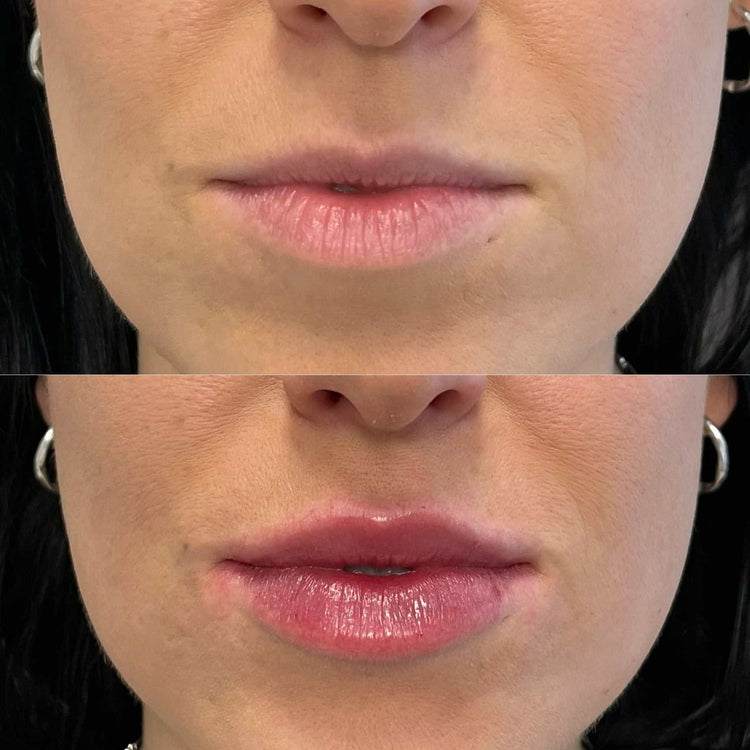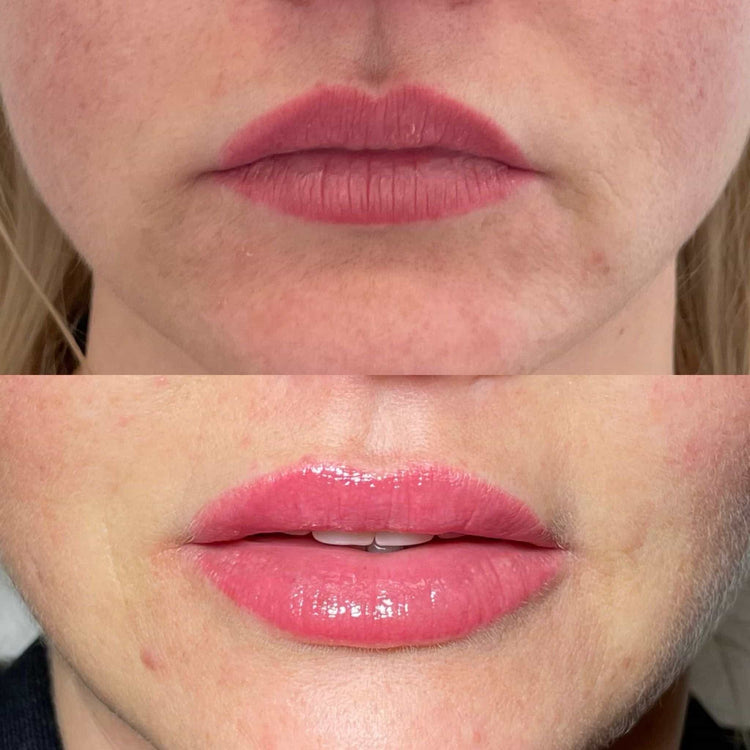Pain-Free Lip Fillers vs. Anaesthetised Fillers
Considering lip fillers in the UK? You might be wondering about the difference between “pain-free” and anaesthetised options. Both aim to minimise discomfort during the procedure, but they achieve this in different ways. Understanding these distinctions can help you make an informed decision about the best approach for your needs and preferences.
Types of Pain-Free Lip Fillers
Pain-free lip fillers are designed to minimize discomfort without the use of traditional anaesthesia injections. These often utilize advanced techniques or formulations that reduce sensitivity during the procedure, aiming for a more comfortable experience. Anaesthetised lip fillers, on the other hand, involve injecting a local anaesthetic into the area prior to filling, effectively numbing the lips and surrounding tissues.
Popular types of pain-free lip fillers often include those that incorporate lidocaine or prilocaine directly into the filler gel itself. These ingredients act as local anaesthetics, reducing the sensation of discomfort during injection. Some clinics also utilize topical numbing creams to further minimize any potential sting.
How Pain-Free Fillers Work
Pain-free lip fillers and anaesthetised fillers both aim to make the lip augmentation process more comfortable, but they work in different ways. Anaesthetised fillers use a local anaesthetic injection to numb the area before the filler is injected, effectively eliminating pain during the procedure.
Pain-free fillers, on the other hand, focus on minimizing discomfort without traditional anaesthesia injections. This can be achieved through various techniques and formulations. Some popular pain-free fillers include those that incorporate lidocaine or prilocaine directly into the filler gel. These ingredients act as local anaesthetics, reducing the sensation of discomfort during injection. Additionally, some clinics may use topical numbing creams applied to the lips before the procedure.
Benefits of Pain-Free Lip Fillers
Pain-free lip fillers offer several benefits over traditional lip fillers that utilize local anaesthesia injections. Firstly, they eliminate the need for an additional injection, reducing the overall number of needles involved in the procedure. This can be especially appealing to individuals who are apprehensive about needles or have a history of experiencing discomfort with injections.
Secondly, pain-free fillers often result in a shorter treatment time as the numbing process is integrated into the filler itself rather than requiring a separate injection stage. Thirdly, some patients find that pain-free lip fillers lead to less bruising and swelling post-treatment, as the absence of anaesthetic injections can reduce inflammation.
Finally, the use of pain-free fillers allows for greater precision during the procedure, as the patient is not numbed and can communicate more readily with the practitioner about their comfort levels and desired outcomes.
Drawbacks of Pain-Free Lip Fillers
Despite their advantages, pain-free lip fillers do have some potential drawbacks. One concern is that the numbing agents incorporated into these fillers may not be as effective as traditional local anaesthetic injections in completely eliminating pain during the procedure. Some individuals may still experience mild discomfort or sensitivity, particularly if they have a low pain threshold.
Additionally, certain pain-free fillers might contain higher concentrations of lidocaine or prilocaine to achieve adequate numbing, which could potentially lead to side effects like temporary skin discoloration or allergic reactions in some individuals. It’s crucial to discuss any potential allergies or sensitivities with the practitioner beforehand.
Finally, the effectiveness and longevity of pain-free fillers can vary depending on individual factors such as skin thickness, metabolism, and the specific type of filler used.
Anaesthetised Lip Fillers
In the UK, lip augmentation has become increasingly popular, with numerous options available to enhance lip volume and shape. Two common approaches are “pain-free” lip fillers and those using anaesthesia. Understanding their distinct mechanisms is essential for individuals seeking a comfortable experience.
Types of Anaesthetics Used
Pain-free lip fillers aim to minimize discomfort without traditional anesthetic injections. They often utilize lidocaine or prilocaine, local anesthetics, incorporated directly into the filler gel. Some clinics also employ topical numbing creams before the procedure.
Anaesthetised lip fillers involve injecting a local anesthetic like lidocaine or prilocaine into the area prior to filling, effectively numbing the lips and surrounding tissues.
Procedure with Anaesthesia

Both pain-free and anaesthetised lip fillers aim to enhance the comfort of your lip augmentation experience.
- Pain-free lip fillers work by incorporating local anesthetics, like lidocaine or prilocaine, directly into the filler gel. This provides localized numbing during the injection process. Some clinics might also utilize topical numbing creams on the lips before the procedure for additional comfort.
- Anaesthetised lip fillers involve a separate injection of a local anesthetic, typically lidocaine or prilocaine, into the area where the filler will be injected. This numbs the lips and surrounding tissues, eliminating pain during the procedure.

Benefits of Anaesthetised Fillers
Pain-free lip fillers offer several benefits over traditional fillers that utilize local anaesthetic injections. Firstly, they eliminate the need for an additional injection, reducing the overall number of needles involved in the procedure. This can be especially appealing to individuals who are apprehensive about needles or have a history of experiencing discomfort with injections.
Secondly, pain-free fillers often result in a shorter treatment time as the numbing process is integrated into the filler itself rather than requiring a separate injection stage. Thirdly, some patients find that pain-free lip fillers lead to less bruising and swelling post-treatment, as the absence of anaesthetic injections can reduce inflammation.
Finally, the use of pain-free fillers allows for greater precision during the procedure, as the patient is not numbed and can communicate more readily with the practitioner about their comfort levels and desired outcomes.
Drawbacks of Anaesthetised Fillers
Despite their advantages, pain-free lip fillers do have some potential drawbacks. One concern is that the numbing agents incorporated into these fillers may not be as effective as traditional local anesthetic injections in completely eliminating pain during the procedure. Some individuals may still experience mild discomfort or sensitivity, particularly if they have a low pain threshold.
Additionally, certain pain-free fillers might contain higher concentrations of lidocaine or prilocaine to achieve adequate numbing, which could potentially lead to side effects like temporary skin discoloration or allergic reactions in some individuals. It’s crucial to discuss any potential allergies or sensitivities with the practitioner beforehand.
Finally, the effectiveness and longevity of pain-free fillers can vary depending on individual factors such as skin thickness, metabolism, and the specific type of filler used.
Comparison Chart
This comparison chart outlines the key differences between pain-free lip fillers and lip fillers that utilize traditional anaesthetic injections in the UK. Both aim to minimize discomfort during the procedure but achieve this through distinct methods. Understanding these distinctions can help you make an informed decision about the best approach for your individual needs and preferences.
Pain Levels
Pain-Free Lip Fillers
- Minimize discomfort without traditional anesthetic injections.
- Utilize lidocaine or prilocaine directly in the filler gel.
- May also use topical numbing creams.
- Fewer needles involved, shorter treatment time.
- Potentially less bruising and swelling.
- Greater precision during the procedure due to patient feedback.
Anaesthetised Lip Fillers
- Involve injecting a local anesthetic (lidocaine or prilocaine) before filler.
- Numbing eliminates pain during the procedure.
- May cause longer treatment time due to separate injection stage.
Cost
Pain-free lip fillers offer several benefits over traditional lip fillers that utilize local anaesthetic injections. Firstly, they eliminate the need for an additional injection, reducing the overall number of needles involved in the procedure. This can be especially appealing to individuals who are apprehensive about needles or have a history of experiencing discomfort with injections.
Secondly, pain-free fillers often result in a shorter treatment time as the numbing process is integrated into the filler itself rather than requiring a separate injection stage. Thirdly, some patients find that pain-free lip fillers lead to less bruising and swelling post-treatment, as the absence of anaesthetic injections can reduce inflammation.
Finally, the use of pain-free fillers allows for greater precision during the procedure, as the patient is not numbed and can communicate more readily with the practitioner about their comfort levels and desired outcomes.
- Pain-free lip fillers utilize lidocaine or prilocaine directly in the filler gel, numbing the lips during injection.
- Anaesthetised lip fillers involve a separate injection of local anesthetic prior to filling, effectively eliminating pain.
The cost of pain-free lip fillers can vary depending on several factors, including the volume of filler used, the specific brand and type of filler chosen, the practitioner’s experience and location, and any additional treatments or services included.
Anaesthetised lip fillers may have a slightly higher upfront cost due to the additional injection of local anaesthetic. However, it’s essential to consider the overall costs associated with each option, including potential costs for post-treatment care such as numbing creams or pain relievers if needed.
It is always recommended to consult with a qualified and experienced practitioner to discuss your individual needs, goals, and budget. They can provide personalized advice and help you choose the most suitable lip filler option for you.
Duration of Results
Pain-free lip fillers aim to minimize discomfort by incorporating local anesthetics like lidocaine or prilocaine directly into the filler gel. Anaesthetised lip fillers involve a separate injection of a local anesthetic, typically lidocaine or prilocaine, before the filler is injected.
Both options aim for a comfortable experience during the procedure, but they achieve this through different methods. Pain-free fillers rely on localized numbing within the gel itself, while anaesthetised fillers involve an additional injection to numb the area beforehand.
Pain-free lip fillers often offer the advantage of fewer needles involved and a potentially shorter treatment time as the numbing process is integrated into the filler. They may also lead to less bruising and swelling post-treatment.
However, the numbing effectiveness of pain-free fillers might not be as potent as traditional anesthetic injections for individuals with a low pain threshold. It’s important to discuss potential side effects like skin discoloration or allergic reactions with your practitioner, especially if you have sensitivities.
- Pain-free lip fillers use localized anesthetics within the filler itself, minimizing discomfort during injection.
- Anaesthetised fillers involve a separate injection of local anesthetic before filling, providing more complete numbness during the procedure.
The duration of results for both pain-free and anaesthetic lip fillers generally lasts between 6 to 18 months. However, this can vary based on factors such as the individual’s metabolism, lifestyle, and the type of filler used.
Regular top-up treatments are typically needed to maintain the desired fullness and shape of the lips over time.
Achieve a natural, fuller pout painlessly at It’s Me & You Clinic with Dr. Laura Geige.
- Retinol Peel Kingston Upon Thames Before And After Results - June 2, 2025
- What Is Breadcrumbing And How Does It Affect Your Dating Life? - June 2, 2025
- Neck Line Filler Treatment Near Hersham, Surrey - June 2, 2025
